Japan Society Educator's Tour - Day 1 (Kyoto)
We went to three different places in Kyoto today. First stop was the Sanjusangendo (三十三限度) Temple. I actually already wrote about it, because I was responsible for posting to the Teacher Blog for that particular site. So rather than reinvent the wheel, I'll post it here: ================================== I think I speak for all when I say our first night in Kyoto turned into our first early morning in Kyoto as well. Waking up at 4:30 AM can be either a blessing or a curse, but our group chose the former by using the early morning to catch up on emails from home and exploring the surrounding streets near our hotel. After a great buffet breakfast, we took a bus to the Sanjusangendo Temple. Robert began by gathering us together outside in the main courtyard where we learned much of the background history for this significant building. Armed with our notes and knowledge of what lay inside, we entered the main foyer where we had to remove our shoes. The entire place was redolent with sandalwood incense and we followed the crowd through the wooden corridor which led into the main room of the temple. Our first look at the nearly identical 1001 bodhisattva was an eye-full. The long temple we’d seen from the outside was literally the holding space for these amazing statues. Turning that corner made it seem as if we were the players on the stage, not the audience, as these silent sentinels observed our entry. And in front of this huge gathering were 28 deities, each one unique in its appearance. But my personal favorites, by far, were Raijin and Fuujin gods of lightning and wind respectively. Back in New York City, we’d had a lesson in the art of the Tokugawa Period and the professor had brought an image of these two god in painted form. The statues were that much more impressive in reality. Now, being the only science teacher on this tour, I was very happy when George, another tour member, pointed out one of the displays on our way out of the building. It detailed how the engineers of this temple planned for earthquakes in their design of this temple, using a technique called “Hanchiku.” Essentially, the foundation of the temple consists of alternating layers of sand and clay, providing a cushion for the temple to shift upon during a disturbance. Even the moat, surrounding the building, was supposed to act as a buffer zone between the shifting planes of the earth’s surface!
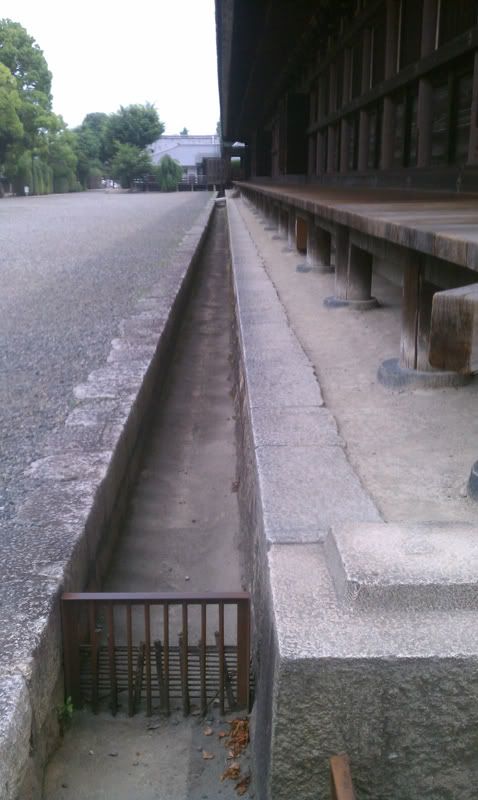
In addition, the timber framework was fitted in such a way to allow the temple to shake without shaking apart. This is very similar to the technology we use today in high rise buildings, allowing them to shake a little in the wind and not be shattered by it. Exiting the temple, I found that they had omikuji in the giftshop. For 100 yen, you get to pick a random fortune. If it’s a good fortune, you want to keep it. However, if it’s a bad one, you don’t want it to stick to you. So, you “get rid” of the bad luck by tying it to the wooden framework outside the temple. Since mine was “not so good, not so bad” I figured that I should probably leave it behind. :)
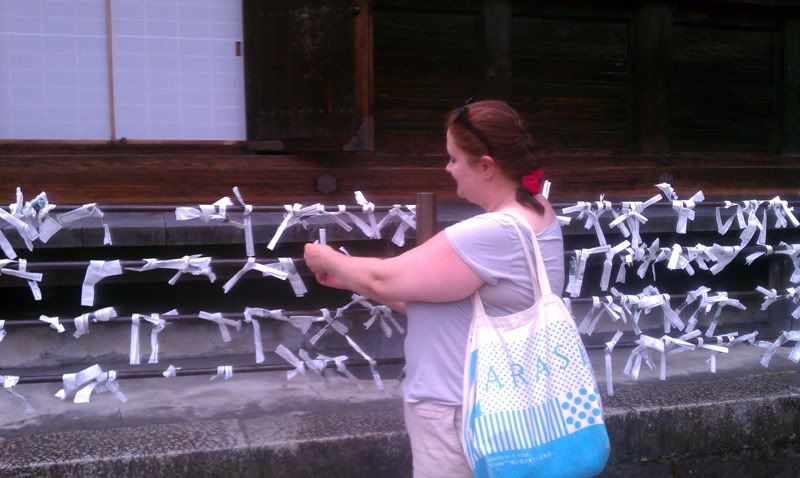
In all, it was a fascinating first look at Japan’s past. (By the way, you can read the original posts from all the teachers HERE. Funny thing is... I'm the only one who's posted so far!
) ================================== From there, we walked to a place called "The Ear Mound." As you may have surmised, it has to do something with ears, and apparently (according to some scholars) there is a debate whether or not there are ~38,000 ears or 38,000 noses buried within it.
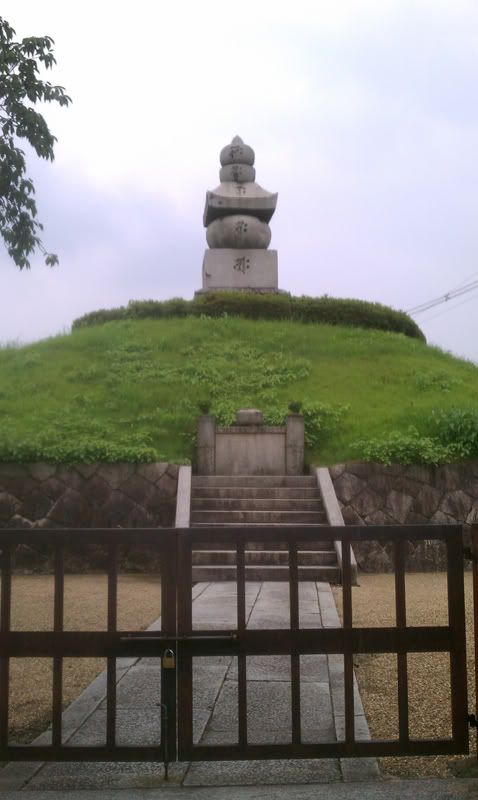
It was created when Hideyoshi Toyotomi was attempting to invade Korea. Soldiers were paid for every head they brought back from the war. However, since heads were a bit cumbersome, ears or noses were accepted instead. Fascinating aspect about this monument is the fact that very few Japanese people are aware of it, but much of Korea know of its existence. In fact, as you can see from this other picture I took, the mound serves as a backdrop for a kid's playground.
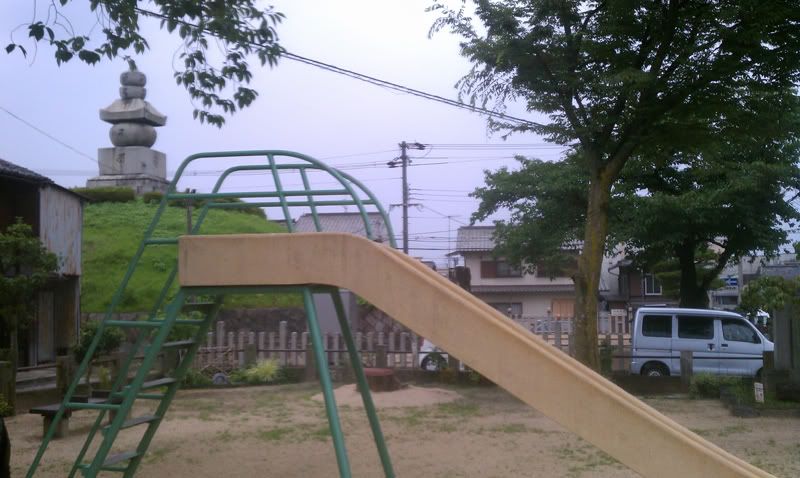
Afterwards, we got on to a bus and returned to the hotel. For lunch, we went under the JR station (the local railroad - NY folks, think Metro North) and picked a cafe to eat. It was called "Gourmet Sandwich" and I ended up with a ham-egg salad-cheese sandwich and a tuna-egg salad sandwich with fries and a mango au lait. In the afternoon, we headed to the Golden Pavilion, otherwise known as Kinkakugi. It was a lovely shrine, looking like it was planted in the water, and literally golden in color.
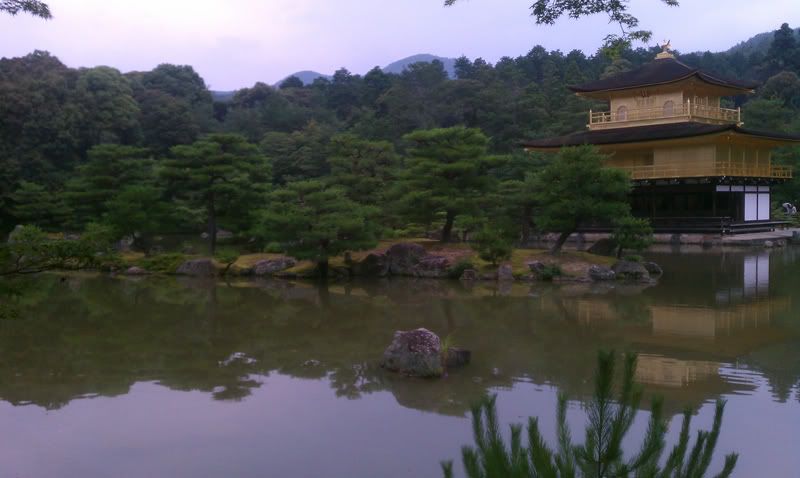
The entire surroundings are man-made, with the islands in the lake representing the islands of Japan. The original shrine was burned down in 1950 and was rebuilt as close to the original as possible.
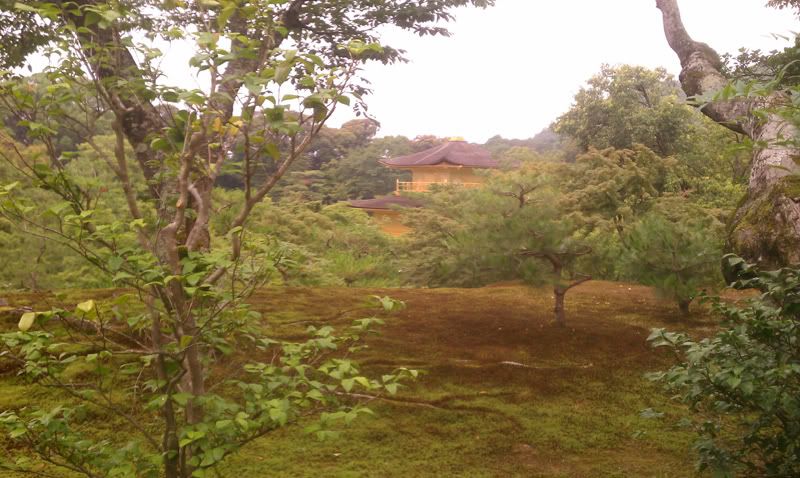
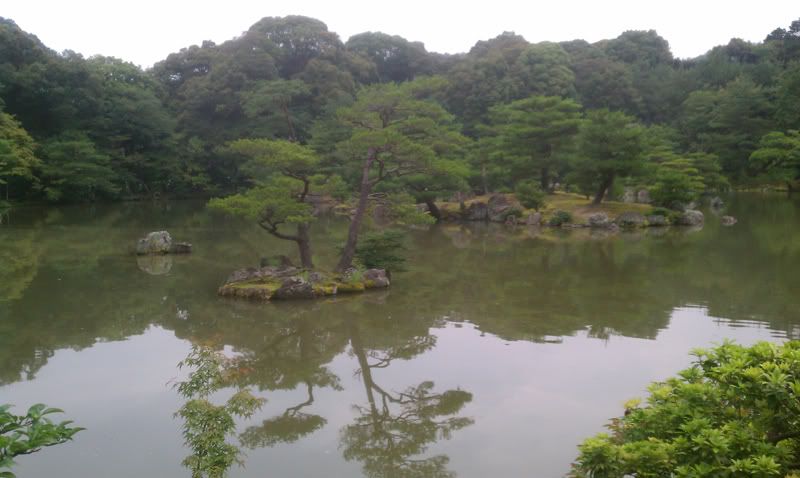
There was a place, at one point, where you could throw a coin at a stone bowl, and if you made it in, then you had good luck. So lots of people were trying to get it in, and I managed to do so on the second toss.
Later, as we were on the way out, we passed by a small group of middle school kids who were trying to practice their English by offering us cranes they had folded out of origami! They were so cute.
For dinner, we ended up going to this super nice Japanese restaurant where we had to take off our shoes and sit on mats while the waitresses who served us were dressed up in yukatas. I ended up with a sushi set, including tempura and udon. Yummy! I will probably be updating Days 2 and 3 from the train ride to Kochi tomorrow, since we'll be doing a lot of siting at that time. I'll be meeting my first host family tomorrow!

In addition, the timber framework was fitted in such a way to allow the temple to shake without shaking apart. This is very similar to the technology we use today in high rise buildings, allowing them to shake a little in the wind and not be shattered by it. Exiting the temple, I found that they had omikuji in the giftshop. For 100 yen, you get to pick a random fortune. If it’s a good fortune, you want to keep it. However, if it’s a bad one, you don’t want it to stick to you. So, you “get rid” of the bad luck by tying it to the wooden framework outside the temple. Since mine was “not so good, not so bad” I figured that I should probably leave it behind. :)

In all, it was a fascinating first look at Japan’s past. (By the way, you can read the original posts from all the teachers HERE. Funny thing is... I'm the only one who's posted so far!

) ================================== From there, we walked to a place called "The Ear Mound." As you may have surmised, it has to do something with ears, and apparently (according to some scholars) there is a debate whether or not there are ~38,000 ears or 38,000 noses buried within it.

It was created when Hideyoshi Toyotomi was attempting to invade Korea. Soldiers were paid for every head they brought back from the war. However, since heads were a bit cumbersome, ears or noses were accepted instead. Fascinating aspect about this monument is the fact that very few Japanese people are aware of it, but much of Korea know of its existence. In fact, as you can see from this other picture I took, the mound serves as a backdrop for a kid's playground.

Afterwards, we got on to a bus and returned to the hotel. For lunch, we went under the JR station (the local railroad - NY folks, think Metro North) and picked a cafe to eat. It was called "Gourmet Sandwich" and I ended up with a ham-egg salad-cheese sandwich and a tuna-egg salad sandwich with fries and a mango au lait. In the afternoon, we headed to the Golden Pavilion, otherwise known as Kinkakugi. It was a lovely shrine, looking like it was planted in the water, and literally golden in color.

The entire surroundings are man-made, with the islands in the lake representing the islands of Japan. The original shrine was burned down in 1950 and was rebuilt as close to the original as possible.


There was a place, at one point, where you could throw a coin at a stone bowl, and if you made it in, then you had good luck. So lots of people were trying to get it in, and I managed to do so on the second toss.

Later, as we were on the way out, we passed by a small group of middle school kids who were trying to practice their English by offering us cranes they had folded out of origami! They were so cute.

For dinner, we ended up going to this super nice Japanese restaurant where we had to take off our shoes and sit on mats while the waitresses who served us were dressed up in yukatas. I ended up with a sushi set, including tempura and udon. Yummy! I will probably be updating Days 2 and 3 from the train ride to Kochi tomorrow, since we'll be doing a lot of siting at that time. I'll be meeting my first host family tomorrow!
